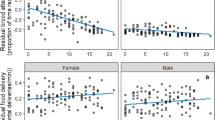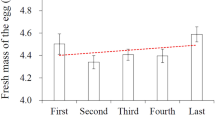Abstract
More than 90% of avian species exhibit biparental care, though parental activities are often shared unequally between the members of a pair. Among gull species (Laridae), males and females generally share parental activities, although there appear to be considerable differences between species in the relative contribution of each sex. This study examined the behaviour of male and female Sabine's gulls (Xema sabini) during the incubation period and immediately post-hatch; particularly the amount of time they each invested in breeding activities. Although considered an aberrant species in aspects of behaviour and biology, the Sabine's gull showed a high reproductive investment by both sexes, as other gull species do. Males fed females prior to egg laying and contributed equally to incubation and chick provisioning, and females contributed equally to nest defence. Overall, there was no difference between the sexes in the extent of their contributions to parental care, although there was considerable individual variation within pairs. Sabine's gulls are Arctic breeders and the extent of their contributions to parental activities could have been influenced by their extreme breeding environment and short breeding season.
Similar content being viewed by others
References
Abraham DM (1986) Observations on the breeding biology of Sabine's gull (Xema sabini). Can J Zool 64:898–903
Brown RGB, Blurton-Jones NG, Hussell, DJT (1967) The breeding behaviour of Sabine's gull (Xema sabini). Behaviour 28:110–140
Burger J (1981) Sexual differences in parental activities of breeding black skimmers. Am Nat 117:975–984
Butler RG, Janes-Butler S (1983) Sexual differences in the behavior of adult great black-backed gulls (Larus marinus) during the pre- and post-hatch periods. Auk 100:63–75
Chu PC (1998) A phylogeny of the gulls (Aves: Larinae) inferred from osteological and integumentary characteristics. Cladistics 14:1–43
Day RH, Stenhouse IJ, Gilchrist HG (2001) Sabine's Gull (Xema sabini). In: Poole A, Gill F (eds) The birds of North America, No. 593. The birds of North America, Philadelphia
Dulude A-M, Baron G, McNeil R (1987) Role of male and female ring-billed gulls in the care of young and territorial defense. Can J Zool 65:1535–1540
Forchhammer M, Maagaard L (1991) Breeding biology of Sabine's Gull (Larus sabini) in Northeast Greenland. Dansk Orn Foren Tidsskr 85:53–62
Furness RW, Monaghan P (1987) Seabird ecology. Blackie, London
Gill FB (1994) Ornithology, 2nd edn. Freeman, New York
Griffiths R, Double M, Orr K, Dawson R (1998) A DNA test to sex most birds. Mol Ecol 7:1071–1075
Hand JL (1986) Territory defense and associated vocalizatons of western gulls. J Field Ornithol 57:1–15
Houston AI, Davies NB (1985) The evolution of cooperation and life history in the Dunnock (Prunella modularis). In: Sibly R, Smith R (eds) Behavioural ecology: ecological consequences of adaptive behaviour. Blackwell, Oxford, pp 471–487
Lack D (1968) Ecological adaptations for breeding in birds. Methuen, London
Ligon JD (1983) Cooperation and reciprocity in avian social systems. Am Nat 121:336–384
Ligon JD (1999) The evolution of avian breeding systems. Oxford University Press, Oxford
Montevecchi WA, Porter JM (1980) Parental investments by seabirds at the breeding area with emphasis on northern gannets (Morus bassanus). In: Burger J, Olla BL, Winn HE (eds) Behavior of marine animals, vol 4. Plenum, New York, pp 323–365
Morris RD (1987) Time-partitioning of clutch and brood care activities in herring gulls: a measure of parental quality? Stud Avian Biol 10:68–74
Morris RD, Bidochka MJ (1982) Mate guarding in herring gulls. Colon Waterbirds 5:124–130
Nelson JB (1978) The gannet. Buteo Books, Vermillion
Pierotti R (1981) Male and female parental roles in the western gull under different environmental conditions. Auk 98:532–549
Silver R, Andrews H, Ball GF (1985) Parental care in an ecological perspective: a quantitative analysis of avian subfamilies. Am Zool 25:823–840
Southern LK (1981) Sex-related differences in territorial aggression by ring-billed gulls. Auk 98:179–181
Steidl RJ, Hayes JP, Schauber, E (1997) Statistical power analysis in wildlife research. J Wildl Manage 61:270–279
Stenhouse IJ, Gilchrist HG, Montevecchi WA (2001) Reproductive biology of Sabine's gull in the eastern Canadian Arctic. Condor 103:98–107
Stenhouse IJ, Gilchrist HG, Montevecchi WA (2003) Predation, anti-predator behaviour and the influence of alternative prey in Sabine's gulls (Xema sabini). Behav Ecol Sociobiol (in press)
Trivers RL (1972) Parental investment and sexual selection. In: Campbell BG (ed) Sexual selection and the descent of man 1871–1971. Aldine, Chicago, pp 136–179
Acknowledgements
We are extremely grateful to the community of Coral Harbour for encouragement and permission to work in East Bay, Southampton Island, Nunavut. We are indebted to Rachel Bryant for her assistance and dedication in the field, to all of the East Bay field crews for their assistance, encouragement and company over the years of this study, and to Keith Lewis for analytical advice. We sincerely thank Anne-Marie Gale and Dr. Steve Carr of the Biology Department, Memorial University of Newfoundland, for their vital role in identifying the sex of individuals from often less than perfect blood samples. This research was supported by the Canadian Wildlife Service (H.G.G.), Natural Sciences and Engineering Research Council of Canada (Individual Operating Grant to W.A.M.), Memorial University of Newfoundland (Graduate Fellowship and Hatcher Scholarship to I.J.S.), and the Polar Continental Shelf Project. We sincerely thank Dr. Carolyn Walsh and two anonymous referees for insightful comments that improved earlier versions of this manuscript.
Author information
Authors and Affiliations
Corresponding author
About this article
Cite this article
Stenhouse, I.J., Grant Gilchrist, H. & Montevecchi, W.A. Reproductive investment and parental roles in Sabine's gulls Xema sabini . J Ethol 22, 85–89 (2004). https://doi.org/10.1007/s10164-003-0106-y
Received:
Accepted:
Published:
Issue Date:
DOI: https://doi.org/10.1007/s10164-003-0106-y




